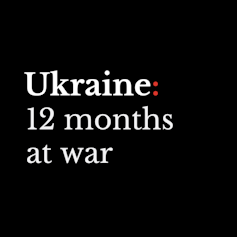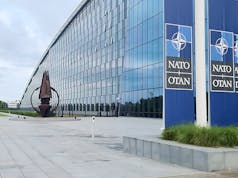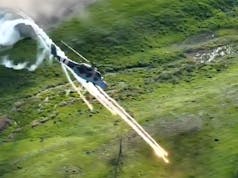Reports from the front lines of the various conflict zones reveal daily just how difficult Ukraine is finding its summer counter-offensive.
Russia has had months to build defensive fortifications and Ukrainian troops are having to fight their way through territory which – according to Oleksiy Danilov, the secretary of Ukraine’s security council – is liberally seeded with landmines.
Written by Jonathan Este, The Conversation. This article is the opinion of the author and not necessarily that of the UK Defence Journal. If you would like to submit your own article on this topic or any other, please see our submission guidelines.
“The number of mines on the territory that our troops have retaken is utterly mad,” he told Ukrainian television this week. “On average, there are three, four, five mines per square metre.”
That said, there is geolocational evidence that Ukraine is gradually pushing back Russian troops in some sectors and there have been suggestions that Ukrainian troops have broken through Russian lines in some area, liberating settlements in the southeast of the country.
Chris Morris, an expert in military strategy at the University of Portsmouth, says that, as part of a concerted push before the weather begins to turn, Ukraine is now committing a significant portion of its available forces to achieve progress. That includes a number of brigades trained and equipped by Kyiv’s Nato allies.
The trouble with the Wagner Group
Russia is having to do without the assistance of Wagner Group fighters, who – following the “mutiny” at the end of June – are now mainly domiciled in neighbouring Belarus, where they are apparently training that country’s armed forces.
As you’d expect, this has prompted deep concern in Warsaw, which is aware of the strategic importance of the Suwalki gap. This is a 60-mile stretch of Polish territory on its border with Lithuania, linking Belarus with the Russian enclave of Kaliningrad. Belarus president Alexander Lukashenko mischievously quipped to Vladimir Putin that he might not be able to control the Wagner mercenaries who, he said, were itching to “go west”.
Natasha Lindstaedt, professor of international relations at the University of Essex with a special interest in non-state paramilitary groups, says that while Lukashenko was clearly joking, mercenary companies such as the Wagner Group are notoriously difficult to control. It remains unclear as to the extent to which their boss, Yevgeny Prigozhin, remains sympathetic to the Kremlin’s war aims. Poland isn’t taking any chances, moving troops to its eastern border to counter any threat from inside Belarus.

Since Vladimir Putin sent his war machine into Ukraine on February 24 2022, The Conversation has called upon some of the leading experts in international security, geopolitics and military tactics to help their readers understand the big issues. You can also subscribe to their fortnightly recap of expert analysis of the conflict in Ukraine.
The role Lukashenko played in dealing with the Wagner Group’s apparent and abortive “rebellion” has given the Belarus leader a degree of leverage with Putin, writes Jennifer Mathers, a senior lecturer in international politics at Aberystwyth University.
As Mathers notes, Lukashenko had previously been beholden to Putin for his political survival. But by providing a face-saving solution that allowed both Prigozhin and Putin to step back from what threatened to be high-risk confrontation, the Belarus leader appears to have regained a degree of autonomy. This, she says, is important as Lukashenko continues his balancing act of trying to acquiesce to Moscow’s demands while also resisting a more direct involvement in a war which is deeply unpopular with his own people.
Scramble for Africa
Prigozhin, meanwhile, was spotted on the fringe of the recent Russia-Africa summit in St Petersburg. The summit followed hot on the heels of Putin’s decision not to renew the grain deal, which had allowed Ukraine to export wheat and other foodstuffs, much of it to African countries. As Stefan Wolff of the University of Birmingham notes, Putin spent a fair bit of time at the gathering trying to justify his decision, which had gone down very badly with those African countries that have been heavily dependent on grain imports from Ukraine.
Wolff writes that Putin’s pledge to “to provide, free of charge, a supply of 25,000–50,000 tonnes of grain each to Burkina Faso, Zimbabwe, Mali, Somalia, the Central African Republic and Eritrea” rings pretty hollow when compared to the volume of food that had been flowing from Ukrainian ports before Russia pulled out of the deal.
But what Putin may not be able to achieve through diplomacy in terms of influence in Africa, Russia’s Wagner Group proxies appear to be securing by propping up unstable regimes (and destabilising others) across west Africa. Wolff sees this as another front in Putin’s cold war against the west.
Crimean Tatars’ guerrilla war
Another important non-state group that is playing an increasingly prominent role in the war – this time on Ukraine’s side – are the Crimean Tatars. The Atesh (fire) movement was formed by fighters from this ethnic group native to the Russian-occupied peninsula. It is waging what appears to be a highly effective guerrilla campaign, disrupting logistics, sabotaging key targets and stoking discontent against – and within – the Russian army.
Gerald Hughes, a reader in military history and intelligence studies at the University of Aberystwyth, tells the story of Crimea’s Tatars. Their history of mistreatment at the hands of the Soviet Union and again by the Russians after Crimea was annexed in 2014 has given them ample reason to mobilise against the invaders.
Whether the Tatars were involved in the recent attack on the Kerch bridge, which links Crimea with the Russian mainland, is not known. It’s the second time the bridge has been badly damaged in an act of sabotage. As well strategically disrupting Russian supply lines, the attack had symbolic importance.
The bridge was a pet project for Putin who drove the first truck across on its completion in 2018 and again after the damage from last year’s attack had been repaired in December last year. As Stefan Wolff writes, following June’s Wagner Group “mutiny”, it’s another blow to Putin’s aura of invincibility.
Russians on the home front
Despite all this, Vladimir Putin’s approval rating at home remains very high: 80% of people told a Statista survey in July they approved of their president’s activities. And polls conducted by the Levada Center consistently record approval ratings of 70% or above towards the conflict in Ukraine, although a majority would like to see an end to the war as soon as possible.
Meanwhile, ordinary people in Russia are doing what they can to support “their boys”, writes Anna Matveeva, a visiting senior research fellow at King’s College London who specialises in conflict and peace studies. Matveeva has spoken with ordinary Russians who either donate funds or run grassroots campaigns to provide everything from stretchers and medical supplies to drones and other weaponry to help fill perceived shortfalls.
As Matveeva notes, these volunteers tend to be solidly middle class. Oligarchs are “conspicuous by their absence”, she says. But there’s a sense that by helping the men at the front, it could reduce the prospect that their own sons might be called up.
Nato matters
One of Russia’s stated aims in invading Ukraine was to combat what it saw as Nato’s pernicious expansion into its neighbourhood. So the announcement last month that Turkey and Hungary had dropped their objections to Sweden joining the alliance will have come as a desperate blow.
Sweden’s accession to Nato – coming hot on the heels of Finland’s in April – will vastly strengthen the alliance’s presence across Russia’s western borders, write international relations experts Simon J. Smith of Loughborough University and Jordan Becker of the United States Military Academy West Point.
In a sense, the accession of Sweden and Finland were fairly predictable in the face of Russia’s aggression towards its neighbour Ukraine. And it recalls the reason that Nato came into being in the first place. By 1949, Soviet plans for expansion in eastern Europe and Germany were becoming increasingly clear, especially with the blockade of Berlin still in place. The North Atlantic Treaty Organisation, to give Nato its full name, was the obvious response.
As Jan Ruzicka and Gerald Hughes – experts in international security and military history at the University of Aberystwyth – write, the foundation of Nato nearly 75 years ago has parallels with today:
“The most decisive impulse to Nato’s existence came from a threat to a people and a territory that were not originally part of the alliance. The Federal Republic of Germany (West Germany) only became a Nato member in May 1955. Today, Ukraine’s resistance has clearly reinvigorated Nato.”![]()
Jonathan Este, Senior International Affairs Editor, Associate Editor, The Conversation. This article is republished from The Conversation under a Creative Commons license. Read the original article.














… and of course Turkey’s accession was directly due to Stalin’s intimidation and threats to force it to surrender territory and give Russia equal right of control over the Bosporous.
Yes it’s a natural response. Russia threatens it’s neighbours with invasion, murder, rape, looting and an insidious state control apparatus akin to the Gestapo and then wonders why people want to join NATO or actively resist Russian claims they came to liberate them.
Liberation at the business end of a gun isn’t liberation.
Watching two of the original four founding members of the USSR charter, slaughtering each other with gay abandon. Is somehow righteous and could be taken as divine retribution for the marxist evil they inflicted on the world. Got to admit that deep down it pleases me to see the devastation. (Despite my periods of undeserved sympathy for the red civilian beasts.)
It seems the Ukrainians are losing troops at a ratio of between 7:1 and 10:1 while assaulting Russian defences in depth. 40,000+ KIA since the current offensive started. If the Kiev Rus don’t start levelling things up soon. It will be all over by Xmas. I wish there were some way to redress the balance, bringing Belarus and the states that constituted Transcaucasia into the meat grinder, for good measure. When one considers the crimes the four of them committed while conjoined in communist sin. It peeves me that U and R get to slaughter each other and the Belarusians and Transcaucasus lot escape unscathed. There must be something NATO can do behind the scenes.
To that end, I have a cunning plan!
You will note I’ve given up on the hope that a peaceful outcome would be preferable for all concerned. Being a die hard optimist, I’m now looking for the silver lining to all this carnage and waste of NATO weapons. I say give the Ukrainians soviet era chemical weapons via Georgian dissidents, Chechen and Tartar mujahadeen. That should kick things off nicely.
Next stop Beijing.
Or give Ukraine nuclear weapons…then let Ukraine give Russia an ultimatum. But this is what is going to happen: The endless conventional trench warfare is going to end in a stalemate, the west will lose interest in supplyingarms, Ukraine will concede territory and Russia will have it’s landbridge to the Crimea. Ukraine will join the EU. In that situation who is the winner? The only other alternative is NATO directly fighting Russia in Ukraine, but there is zero political will in the west for this to happen.
Subject matter still above your low pay grade I see.
As far as the defence channels on Youtube are concerned the UkR army high command are still undertaking “shaping” operations, using long-range artillery, HIMARS, Storm Shadow/SCALP and their own drones to attack Russian command bunkers, senior Russian commanders, ammunition dumps, troop concentrations, electronic warfare vehicles etc
They have also been undertaking armoured probes into Russian defences, looking for weak areas, using cluster bombs to detonate minefields.
Last week UkR attacked bridges linking Crimea to the mainland and reports were posted by Russian milbloggers that UkR artillery was interdicting three main roads into Russian held territory just north of the bridges. Ordinary artillery has a range of 15-20 miles and so we can deduce that UkR forces have penetrated deeply into this region
I have not heard of Chris Morris at the University of Portsmouth, perhaps he would like to post his sources for his assertion that UkR has committed it’s reserve, as there appears to be no confirmation of this elsewhere (such as the ISW)